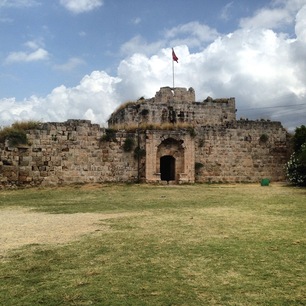“Small Shore” (Yakacık) Population: 36,900
Old name: Baiae (Hellenistic)
Market day: Wednesday
***The Hatay was terribly damaged by the earthquakes of 2023. As far as I know the historic structures of Payas survived but I have not been back since.***
North of İskenderun the small town of Payas is home to the huge and impressive Sokollu Mehmet Paşa külliye (mosque complex); head towards the sea when you get off the dolmuş to find it.
The great 17th-century Ottoman travel writer Eliya Çelebi visited Payas and recorded its residents putting up a strenuous fight against pirates who preyed on passing ships and caravan trains.
From the Middle Ages the Genoese had a presence in Payas which continued right through until the late 18th century even after the town had passed into Ottoman hands. When they were finally driven out the town fell into the hands of a local warlord callled Küçük Ali (Little Ali) who was himself little more than a pirate preying on passing traders, his antics culminating in the capture of the Dutch consul to Aleppo in 1801. Küçük Ali died in 1808 but his son, Dada Bey, continued the tradition of piracy and hostage-taking until 1817 when he was executed in Adana.
Around town
The mosque complex was built in 1574 for Sultan Selim II and the great Ottoman architect Sinan is thought to have advised on the design.
The enormous covered bazaar has been restored and is now full of shops again, and there’s also a double hamam (Turkish bath) and an enormous caravanserai which may one day be turned into a hotel but in the meantime comes in handy for local celebrations.
Heart of the complex is the Sarı Selim Cami, inconspicuously tucked away beside a pretty courtyard dotted with bits of old masonry, presumably from ancient Baiae. The impressively striped entrance is reminiscent of mosques in Gaziantep. It must once have been ringed with porticoes but today only the plinths that supported the columns remain. (Sarı Selim was Sultan Selim II, nicknamed Selim the Blond.)
Beside the complex is a huge moated castle originally built by the Crusaders but rebuilt by the Ottomans in the 16th century. Later it was used as a prison. There’s a fine view of the mosque complex from its walls.
After visiting the castle continue walking down towards the sea to find the Cin Kulesi (Djinn Tower) which sits at one end of a picnic area. There’s a strip of beach here but given the proximity of heavy industry it’s probably not wise to go into the water.
Sleeping

There are several hotels in Payas but you’re probably better off continuing to İskenderun for a better choice and for the pleasure of the seafront promenade.
Transport
Dolmuşes to Payas run from the main Adana–Antakya road near the Grand Ontur Hotel in İskenderun.


